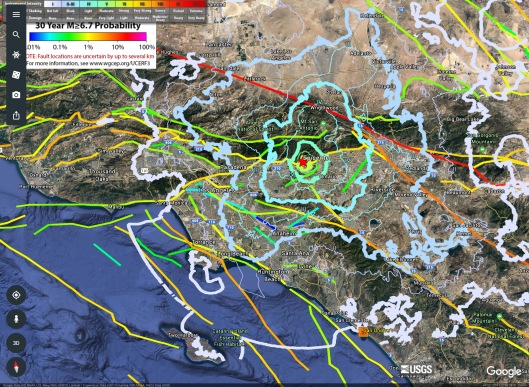Tags
burial of nuclear waste, California, California earthquake hazard, Diablo Canyon, Holtec, La Verne California, Nuclear power and earthquakes, San Onofre, Spent Nuclear Fuel, UCERF3
Yesterday’s California earthquake was small but serves as a good reminder that it might not have been. The first map shows the epicenter and the USGS shake map, along with the probability of large earthquakes along various faultlines. The orange skull indicates San Onofre Nuclear Power Station. Even if you aren’t in California you should care. Even if you think you don’t care if California sinks into the sea, you should care, because millions of Californians could be coming your way. And, in the event of a nuclear accident, some of the radiation will also come your way. San Onofre Nuclear Generating Station is closed, but nuclear fuel still remains on site, and is being buried in flimsy spent fuel canisters there. Diablo Canyon Nuclear Generating Station will remain open for six more years. Closing isn’t closed. A lot can happen in six years.

M 4.4 – 4km N of La Verne, CA 2018-08-29 02:33:28 UTC 34.140°N 117.773°W & San Onofre Nuclear Power Station & UCERF3 (UTC is 7 hours ahead of California so this earthquake occurred on the 28th.)

California UCERF 3 nuclear power stations

San Onofre Nuclear Generating Station URCERF3

Diablo Canyon Nuclear Generating Station & UCERF3

Sandia National Lab and UCERF3
Excerpt from San Onofre Safety:
“ * Tom Palmisano (Edison) disclosed at the September 2017 Community Engagement Panel meeting that partially cracked canisters have no earthquake (seismic) rating and Edison has no current ability to know if any of these canisters are cracking. https://youtu.be/33FwTTMZLNI
* The NRC states once a crack starts it can grow through the canister wall in about 16 years. The existing 51 Areva NUHOMS thin-wall canisters have been at San Onofre for up to 14 years. https://sanonofresafety.files.wordpress.com/2013/06/ml14258a081-8-5-14meetingsummary.pdf
* A Diablo Canyon thin-wall canister (also located along the California coast) was found to have conditions for cracking in a two-year old canister.
* https://sanonofresafety.files.wordpress.com/2011/11/diablocanyonscc-2014-10-23.pdf
* Coastal Commission staff report said cracks would not start for 30 years per the NRC August 5, 2014 document. However, the staff did not report that this was before the NRC knew that conditions for cracking could occur in only two years with temperatures low enough on the canister to dissolve salt particles.
* Given this incorrect information regarding 30 years before a crack could start and the fact partially cracked canisters do not have a seismic earthquake rating, the Commission made their decision with incorrect information.
* Instead of requiring that Edison solve these problems before granting a Coastal permit, Edison received Coastal Commission permit to load 73 more thin-wall canisters in a partially buried unproven system, with only a promise they will solve these problems. See Holtec UMAX canister system.
* https://sanonofresafety.org/holtec-hi-storm-umax-nuclear-waste-dry-storage-system/
* Commissioner Shallenberger grills NRC Mark Lombard and Edison’s Tom Palmisano about lack of ability to inspect for cracks (video). Neither Lombard or Palmisano mentioned that even if they could find cracks in these thin-wall canisters, they have no plan in place to repair or replace canisters…. ”
See this and much much more here: https://sanonofresafety.org
Population in the LA area alone: https://en.wikipedia.org/wiki/Los_Angeles_metropolitan_area
There is apparently spent nuclear fuel still parked at the long closed Rancho Seco Nuclear Generating Station: https://en.wikipedia.org/wiki/Rancho_Seco_Nuclear_Generating_Station
M 4.4 – 4km N of La Verne, CA 2018-08-29 02:33:28 UTC 34.140°N 117.773°W
https://earthquake.usgs.gov/earthquakes/eventpage/ci38038071#executive
(California is 7 hours behind UTC).
Earthquake hazard faultlines exported from: https://www.scec.org/ucerf

You must be logged in to post a comment.